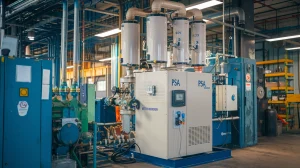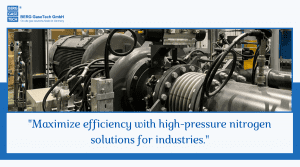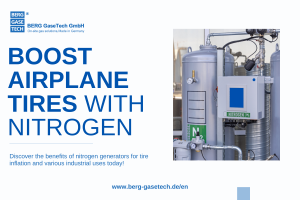Introduction
Nitrogen generators have become essential in food packaging and are now reliable for keeping food fresh. For instance, nitrogen generators are widely used in the food packaging sector. In this blog, we’ll look at how nitrogen generators, which include Pressure Swing Absorption Oxygen gas generators and mini-nitrogen generators, meet the needs of today’s food packaging market. We will proceed to consider the advantages of nitrogen gas, the various kinds of nitrogen generators, and how these generators assist in attaining food safety and sustainability objectives.
Why Nitrogen Is Key for Food Packaging
An example of a preserved gas is nitrogen. Colorless, odorless, ess and tasteless gas is used to preserve foods by removing oxygen and rolling back the time clock on ready-made in masses produced goods in packets. Oxygen, as a component of packaging, triggers oxidation, which changes the taste, color, and nutrient content of the food. Nitrogen prevents the invasion of oxygen into the product, reducing the product’s spoilage rate; MAP systems utilize nitrogen gas to manage the environment specific to the food packages and are essential for packaging snack foods, meats, and fruits and vegetables.
PSA (Pressure Swing Adsorption) nitrogen generator for food packaging with a convenient, reliable, and high-purity nitrogen source for Modified Atmosphere Packaging (MAP) without the need for dependence on conventional, non-transparent liquid nitrogen cylinders. This helps to save money and is beneficial as it goes well with today’s environmentally friendly concepts since it eradicates the emission of gasses used in transporting the gas.
Types of Nitrogen Generators for Packaging Needs
This paper focuses on the nitrogen generators utilized in the food packaging industry: cryogenic liquid nitrogen generators, pressure swing adsorption nitrogen generators, membrane nitrogen generators, and digitally controlled nitrogen generators.
PSA Nitrogen Generator
The PSA nitrogen generators function in a manner that separates nitrogen from oxygen in the airstream, primarily by using the selective adsorption technique. Specifically, their high-purity nitrogen production capability of up to 99.999% is highly sought in food packaging applications requiring high quality. One of the advantages of the PSA method is the temporal constancy of nitrogen supply, which is ideal for massive food producers and distributors, who should have a stable nitrogen supply in packaging lines.
Membrane Nitrogen Generators
Membrane nitrogen generators are infrastructures that employ a membrane to filter nitrogen from other gasses. They tend to generate lower PSA purity levels compared to PSA systems. However, they can benefit from better energy efficiency levels and are suitable for processes for which ultrahigh purity levels are unnecessary. It can be assumed that membrane generators may be used for packing in bulk in the food industry, as striving for such high degrees of demineralization is optional in this case.
Mini Nitrogen Generator
Mini nitrogen generators are small and flexible nitrogen packaging units appropriate for use by producers of unique or niche products. These systems are portable, inexpensive, and can offer a consistent nitrogen supply without much-fixed support. Therefore, they are suitable for small-scale businesses or specific uses with a steady demand for nitrogen but at a lower cost than large-scale systems.
The Benefits of On-site Nitrogen Generation
This proves that on-site nitrogen generation has the following benefits compared to conventional nitrogen supply methods: cost of nitrogen supply, environmental impact, and flexibility.
Cost Efficiency
Using fixed nitrogen generators also eliminates costs associated with shipping, renting cylinders, and storage. Recovered nitrogen from bottled nitrogen gas will cost a fortune to purchase, and transporting it can result in other additional costs. However, having an on-site nitrogen generator means that the manufacturer can produce the nitrogen gas needed in the process, hence cutting down costs and avoiding over-dependence on suppliers of that gas.
Environmental Sustainability
The use of nitrogen generated at the site reduces the carbon footprint of food packaging operations since there is no need for frequent nitrogen deliveries. This coincides with society’s increasing concern about the sustainability of food processes. Cutting down greatly on the movement means that there will be less emission of greenhouse gasses, making the companies and the world green. Several organizations, such as the World Food Programme (WFP) and the European Food Safety Authority, support sustainable packaging and acknowledge stationery on-site generation of gasses.
Scalability and Adaptability
They come in sizes for small businesses to large-scale PSA O2 nitrogen generators to suit any manufacturer’s nitrogen requirement. This flexibility allows food producers to produce just as much nitrogen as required, seasonally or otherwise, as it may be determined operationally to be advantageous. Further, on-site systems can be used in the packaging application as they can be tailored to meet the individual purity and flow rate.
Industry Standards and Compliance in Food Packaging
The food packaging sector requires high-standard food safety since it involves packaging food with the intention of preserving the high quality and safety of food products. ISO and FDA, for instance, dictate the quality of gasses and packaging procedures to ensure that consumers are protected from diseases. Nitrogen generators ensure manufacturers meet these standards since they produce high-purity nitrogen suitable for production processes requiring minimal oxygen levels.
These standards require high purity output, and the PSA nitrogen generator meets these standards and, hence, fits the current use like MAP. Therefore, on-site nitrogen generation can be useful for organizations that are pursuing compliance with standards set by ISO or FDA, aiming to maintain the food packing processes as secure, efficient, and environmentally friendly as possible.
Implementing Nitrogen Generators for Optimized Food Quality
Adaptive utilization of nitrogen gas generator for food packaging improves food quality and nutrition and lengthens its shelf life. Nitrogen eliminates oxidation, which is a big plus for food products such as nuts, coffee, or any snack that quickly loses its flavor. Nitrogen also improves the aesthetic value of packaged products since it minimizes the fading of the product’s color.
Modern equipment for generating protective gasses can be connected to high-tech packaging lines for a smooth supply of nitrogen and the required controlled atmosphere packaging. This automation is helpful in large-scale operations since the output is high and the management of the gaseous product is precise. In addition, it has more significant flexibility to adjust on-site nitrogen levels, giving producers the flexibility of the atmospheric packaging requirements of individual products to maximize freshness and consumer experience.
Nitrogen Generators: A Sustainable Investment
On-site nitrogen generation is no longer merely an efficiency improvement—today, it is an environmental imperative in a global market looking for sustainable solutions. The realization of nitrogen on site allows a company to express its care towards the environment and demonstrate competency that enhances functioning. As the need for sustainable practices increases, nitrogen generators assist in the aims of organizations, such as the UN FAO and the Sustainable Packaging Coalition, in driving environmentally friendly strategies within the packaging sector.
Consequently, nitrogen generators present the best advancement in food packaging systems and provide several benefits that align with the principles of the food packaging industry and sustainable developments. If it is required to have nitrogen of the highest purity, one can opt for a PSA nitrogen generator, or if needed, one can go for a mini nitrogen generator; these help the companies to support the cause of food preservation along with keeping the environment in mind at the same time.
FAQ
Q: What are the main benefits of using nitrogen in food packaging?
A: Nitrogen slows deterioration and keeps out ox, enhancing the products’ shelf life and reducing oxidation.
Q: What is the recommended nitrogen purity level for food packaging?
A: 99 – 99.5 % is generally sufficient for most food packaging uses, although specific applications may call for higher or lower purity levels.
Q: How does on-site nitrogen generation contribute to sustainability?
A: The generation of gas on-site has the advantage of cutting down on gas transportation, resulting in less carbon emissions to the atmosphere, promoting an environmentally friendly approach.
Q: What is the typical lifespan of a nitrogen generator?
A: If well maintained, nitrogen generators are relatively long-lived, ranging from 10 to 15 years; therefore, they are relatively cost-effective products.
Q: Are mini nitrogen generators suitable for artisanal food producers?
A: Indeed, mini nitrogen generators are appropriate for small production facilities because they stabilize nitrogen production without vast inputs.Yes, mini nitrogen generators are ideal for small-scale operations, providing consistent nitrogen supply without large infrastructure needs.



